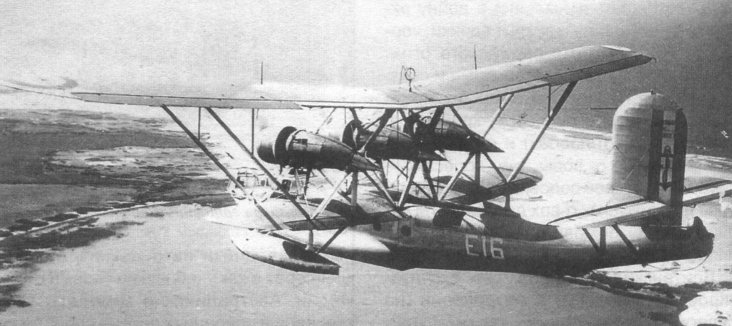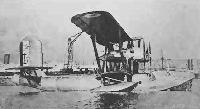
Описание
Страна : Франция
Год : 1933
Летающая лодка
Дальняя морская разведывательная летающая лодка с экипажем из восьми человек
Варианты
- Short - Calcutta / Rangoon / S.8 - 1928 - Великобритания
- Kawanishi - H3K - 1931 - Япония
- Short - Kent / S.17 - 1931 - Великобритания
- Short - Sarafand / S.14 - 1932 - Великобритания
- Breguet - Br.520 Bizerte / Br.530 Saigon - 1933 - Франция
- Short - Scylla / L.17 - 1934 - Великобритания
Br.520 Bizerte / Br.530 Saigon
Летающая лодка, трехмоторный цельнометаллический биплан. Разработан в КБ "Сосьетэ аноним де ателье д'авиасьон Луи Бреге" на базе лицензии на английскую пассажирскую лодку Шорт S.8 "Калькутта" (1931 г.) под руководством А. Лебефа. Французские конструкторы увеличили размах крыла, перешли к схеме полутораплана, сменили тип моторов, разместили вооружение. Опытный образец лодки, Br.521-01, впервые взлетел 11 сентября 1933 г. Позднее этот самолет также привели к серийному стандарту. Серийное производство на заводе "Бреге" (с апреля 1937 г. - SNCAN) в Гавре начато с октября 1935 г. Всего выпущено 37 экз. (без аналогичных гражданских лодок Br.530 "Сайгон").
Экипаж - 8-9 чел. Двигатели GR 14 Kirs1 (на трех последних самолетах GR 14N11). Вооружение 3x7,5, со 2-го серийного самолета 5x7,5, бомбы до 1600 кг или 2 торпеды по 800 кг.
Первая лодка поступила на войсковые испытания в апреле 1935 г., серийные машины попали в боевые эскадрильи с июля того же года.
В ходе серийного производства убрали открытую носовую огневую точку и заменили ее боковыми блистерами, ввели остекленный проход в носовую кабину. В 1937 г. внедрили дополнительные бензобаки в нижнем крыле. Один самолет собрали как Br.522 с моторами HS 14Aa, три последних Br.521 имели моторы GR 14N11 и усовершенствованное оборудование, включая автопилот.
С сентября 1939 г. Br.521 были вооружены четыре эскадрильи, базировавшиеся во Франции, Марокко, Тунисе и Сенегале. Они вели разведку в Средиземном море и Атлантике с целью сопровождения конвоев и поиска подводных лодок. Известны два случая, когда летающим лодкам удалось повредить субмарины бомбами. 3 июля 1940 г., после атаки англичан на французский флот, "бизерты" бомбили два британских эсминца.
После капитуляции Франции самолеты служили в ВВС правительства Виши. Некоторое время они простояли разоруженными в Берре и Карубе, но затем вновь встали в строй. Вели патрулирование и спасательные работы.
В ноябре 1942 г. сохранившиеся лодки захватила Германия и использовала их для спасательных операций в Атлантике. Немецкие пилоты летали на трофейных лодках до капитуляции Германии.
Канадские войска в августе 1944 г. захватили у немцев один Br.521 и передали его французам. После ремонта с октября он вошел в состав французской морской авиации и недолго применялся как транспортный для перевозок из Северной Африки в метрополию. Самолет списали в мае 1946 г. после аварии.
Br.521||
Размах:||35,13 м
Длина:||20,48 м
Моторы, количество х мощность:||3 х 925 л.с.
Взлетная масса, максимальная:||16600 кг
Максимальная скорость:||245 км/ч
Практический потолок:||6000 м
Дальность:||3000 км
Описание:
- Br.520 Bizerte / Br.530 Saigon
- Breguet Bre.520 и Bre.521 Bizerte
- Flight, October 1934
THE BREGUET "SAIGON
Фотографии
-
Мировая Авиация 73
Изображенный здесь Bizerte состоял на вооружении 1-й поисково-спасательной эскадрильи Люфтваффе (I.Seenotstaffel) и зимой 1943-1944 годов базировался в Бресте.
-
Моделист-Конструктор Гидросамолеты Второй мировой войны
Br.521 у западного побережья Африки, начало 1939г.
-
Air Enthusiast 2000-03 / M.Passingham - From Calcutta to Bizerte
The third Bizerte of Escadrille E3 patrolling above the battleship Dunkerque.
-
Air Enthusiast 2000-03 / M.Passingham - From Calcutta to Bizerte
Bizerte E55 on patrol, neatly framed between the lower wing and wingtip float of another flying-boat from the same Escadrille E5.
-
Air Enthusiast 2000-03 / M.Passingham - From Calcutta to Bizerte
Bizerte 6 of Escadrille E1, c/n 21. On the bow the black wolf's head insignia of that escadrille.
-
Air Enthusiast 2000-03 / M.Passingham - From Calcutta to Bizerte
Le Grand Coureur, Bizerte 2 of Escadrille E1. On the tail is the standard inscription 'BREGUET BIZERTE' No.18, indicating the Breguet constructor's number.
-
Моделист-Конструктор Гидросамолеты Второй мировой войны
"Бизерт" из эскадрильи E3 в полете
-
Aeroplane Monthly 1990-09 / P.Metges - Luftwaffe air-sea rescue in the Battle of Britain
Breguet Bizerte flyingboats operated by 1 Seenotstaffel. The first of these French 'boats entered service toward the end of the Battle of Britain.
-
Air Enthusiast 2000-03 / M.Passingham - From Calcutta to Bizerte
Three Bizertes in formation 'stepped up', photographed from a fourth example.
-
Air Enthusiast 2000-03 / M.Passingham - From Calcutta to Bizerte
The 'White Goose in Flight' insignia of Escadrille E5 on the bow of Bizerte E52, No.17.
-
Air Enthusiast 2000-03 / M.Passingham - From Calcutta to Bizerte
In-flight view of Breguet Bizerte No.1 giving a clear indication of the forward hull of this first prototype, including the bow gunner's cockpit, the cabin for the captain/navigator and the raised pilots' cabin behind that.
-
Jane's All the World Aircraft 1980 / Encyclopedia of Aviation - Aircraft A-Z - v2
Breguet 521 Bizerte prototype, with open nose-gunner’s position.
-
Air Enthusiast 2000-03 / M.Passingham - From Calcutta to Bizerte
Bizerte No.1 on the water. The tail layout, complete with rearmost gunner's cockpit, can he seen in detail.
-
Air Enthusiast 2000-03 / M.Passingham - From Calcutta to Bizerte
Believed to be the second Bizerte, retaining the original bow configuration. Photographed at Cherbourg. Machine-gun armament has been installed.
-
Jane's All the World Aircraft 1980 / Encyclopedia of Aviation - Aircraft A-Z - v2
Production Breguet 521 Bizerte with ‘glasshouse’ cockpit extension.
-
Моделист-Конструктор Гидросамолеты Второй мировой войны
Br.521 из эскадрильи E2 стоит на якоре на базе Арзев вскоре после капитуляции Франции
-
Air Enthusiast 2000-03 / M.Passingham - From Calcutta to Bizerte
Bizerte 2 of E9 undergoing the delicate task of being moved by a heavy duty crane.
-
Air Enthusiast 2000-03 / M.Passingham - From Calcutta to Bizerte
The Breguet 522, the only Bizerte with Hispano-Suiza radials
-
Air Enthusiast 2000-03 / M.Passingham - From Calcutta to Bizerte
A Bizerte on beaching trolley gear, an interim experimental version with enlarged balanced rudder as on the civil passenger Saigon flying-boat. It also has two auxiliary fins mounted on the horizontal tailplane.
-
Air Enthusiast 2000-03 / M.Passingham - From Calcutta to Bizerte
Four crew members on top of the forward hull of a Bizerte of Escadrille E2. Note the ‘Caravelle’ insignia of that unit.
-
Flight 1934-10 / Flight
Регистрационный номер: F-AMSV [3] FOR THE MARSEILLES-ALGIERS LINE: Two views of the Breguet "Saigon" at her moorings. Her ancestry is quite apparent.
-
Aeroplane Monthly 1991-03 / J.Stroud - Wings of Peace
Регистрационный номер: F-AMSV [3] F-AMSV Algerie, the first of the two Breguet Saigons.
-
Jane's All the World Aircraft 1980 / Encyclopedia of Aviation - Aircraft A-Z - v2
Регистрационный номер: F-AMSV [3] Breguet Saigon.
-
Aeroplane Monthly 1991-03 / J.Stroud - Wings of Peace
Регистрационный номер: F-AMSX [3] This view of the second Breguet Saigon shows the Short ancestry in hull and wingtip floats.
-
Aeroplane Monthly 1991-03 / J.Stroud - Wings of Peace
Регистрационный номер: F-AMSX [3] The engine mounting and Breguet tail unit show departures from Short Brothers’ practice.
-
Aeroplane Monthly 1991-03 / J.Stroud - Wings of Peace
The forward cabin of the Saigon.
-
Aeroplane Monthly 1991-03 / J.Stroud - Wings of Peace
Регистрационный номер: F-AMSX [3] KEITH WOODCOCK'S painting shows one of the two Air France Breguet 530 Saigons.
-
Моделист-Конструктор Гидросамолеты Второй мировой войны
Breguet Br.521 Bizerte (с моторами GR 14N11)
- Фотографии



























